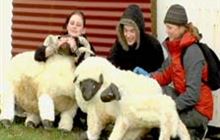History and culture of Mana Island
Introduction
There are signs of human occupation of Mana dating back to the 14th century.Artefacts, like fish hooks, spears, and animal remains, found in middens provide evidence of human occupation of Mana back to the 14th century.
The island is within view of pa sites at Whitireia Park and Plimmerton that belonged to the Porirua tribes Ngati Tara and Ngati Ira.
In the early 1820s, Ngati Toa people from Waikato and Ngati Awa from Taranaki swept into the region. The Ngati Toa leader, Te Rauparaha and his nephew, Te Rangihaeata, both built whare (houses) and developed kumara gardens on Mana.
European occupation of the island began in the 1830s when a whaling station was established and most of the vegetation was cleared to create one of New Zealand’s earliest pastoral farms. New Zealand's second export shipment of wool, in 1832, came from Mana Island. It fetched a higher price than the first shipment from the Bay of Islands two months earlier. The woolshed, dating from the late 1860s, reflects the nature of this early industry. It now houses displays explaining the history and features of the island.
A lighthouse was built at the northern end in 1863 was the second in the province of Wellington. It was designed and prefabricated in London by Simpson and Co. and first lit on 1 February. 1865. Two shipwrecks in 1870 were blamed on the lighthouse due to confusion with the Pencarrow lighthouse and it was extinguished on the 24 September 1877. The lighthouse was re-erected at Cape Egmont where it continues to operate today. The brick foundations of the lighthouse tower and the ditch and bank boundary of the keepers gardens can still be seen today.
Mana Island passed into Crown ownership in 1865 and grazing continued until 1986 when the last cattle were removed. Sheep had been removed earlier after a outbreak of the disease scrapie.
The Department of Conservation took over management of the island in 1987 and began to restore Mana to its natural state.

